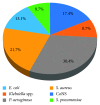Bacterial Nosocomial Infections and Antimicrobial Susceptibility Pattern among Patients Admitted at Hiwot Fana Specialized University Hospital, Eastern Ethiopia
- PMID: 30631777
- PMCID: PMC6305041
- DOI: 10.1155/2018/2127814
Bacterial Nosocomial Infections and Antimicrobial Susceptibility Pattern among Patients Admitted at Hiwot Fana Specialized University Hospital, Eastern Ethiopia
Abstract
Nosocomial infections remain a major cause of mortality and morbidity worldwide. Despite the highly specialized interventions and policies, the rate of infection is still high due to the emergence of antimicrobial-resistant bacteria. This study described the prevalence of bacterial nosocomial infections and antimicrobial susceptibility pattern of isolates among patients admitted at Hiwot Fana Specialized University Hospital, Eastern Ethiopia. A hospital-based cross-sectional study was conducted among 394 nosocomial infection-suspected patients from March 2017 to July 2017. Data were collected using a structured questionnaire. Specimens from the respective site of infections were collected and examined for the presence of pathogenic bacteria and their antimicrobial susceptibility using standard culture and serological tests. Data were summarized using descriptive statistics. The prevalence of culture-confirmed bacterial nosocomial infection was 6.9% (95% CI: 4.3-7.9). Staphylococcus aureus (18.5%) was the most common isolate followed by Escherichia coli (16.7%). S. aureus showed 80% resistance to chloramphenicol and erythromycin, and 70% to cephalexin and tetracycline, respectively. A methicillin-resistant S. aureus made up 88.9% of all S. aureus isolates. Pseudomonas aeruginosa showed 83.7% resistance to each of ceftazidime and cephalexin, and 66.7% to chloramphenicol. The most common multidrug-resistant isolates were P. aeruginosa (30.4%) and S. aureus (21.7%). The prevalence of nosocomial infections in this study was comparable with other findings; however, the high rates of antimicrobial resistant isolates represent a substantial threat to the patients, communities, health care providers, and modern medical practices. Bacterial nosocomial infection treatment should be supported by culture isolation and antimicrobial susceptibility testing.
Figures
Similar articles
-
Prevalence, Antimicrobial Susceptibility Pattern of Bacterial Isolates, and Associated Factors of Urinary Tract Infections among HIV-Positive Patients at Hiwot Fana Specialized University Hospital, Eastern Ethiopia.Can J Infect Dis Med Microbiol. 2019 Feb 6;2019:6780354. doi: 10.1155/2019/6780354. eCollection 2019. Can J Infect Dis Med Microbiol. 2019. PMID: 30881531 Free PMC article.
-
A comparative study on nosocomial and community-acquired bacterial urinary tract infections: prevalence, antimicrobial susceptibility pattern, and associated risk factors among symptomatic patients attending Hiwot Fana Comprehensive Specialized University Hospital, Eastern Ethiopia.Front Epidemiol. 2025 Apr 7;5:1517476. doi: 10.3389/fepid.2025.1517476. eCollection 2025. Front Epidemiol. 2025. PMID: 40259954 Free PMC article.
-
Aerobic Bacterial Profile and Their Antibiotic Susceptibility Patterns of Sterile Body Fluids Among Patients at Hiwot Fana Specialized University Hospital, Harar, Eastern Ethiopia.Infect Drug Resist. 2022 Feb 22;15:581-593. doi: 10.2147/IDR.S351961. eCollection 2022. Infect Drug Resist. 2022. PMID: 35228808 Free PMC article.
-
Microbiologic spectrum and susceptibility pattern of clinical isolates from the pediatric intensive care unit in a single medical center - 6 years' experience.J Microbiol Immunol Infect. 2009 Apr;42(2):160-5. J Microbiol Immunol Infect. 2009. PMID: 19597649 Review.
-
Update on bacterial nosocomial infections.Eur Rev Med Pharmacol Sci. 2012 Aug;16(8):1039-44. Eur Rev Med Pharmacol Sci. 2012. PMID: 22913154 Review.
Cited by
-
Antibacterial and Cytotoxic Silica-Polycaprolactone-Chlorogenic Acid Hybrids by Sol-Gel Route.Molecules. 2023 Apr 15;28(8):3486. doi: 10.3390/molecules28083486. Molecules. 2023. PMID: 37110721 Free PMC article.
-
Magnetite Nanoparticles and Essential Oils Systems for Advanced Antibacterial Therapies.Int J Mol Sci. 2020 Oct 5;21(19):7355. doi: 10.3390/ijms21197355. Int J Mol Sci. 2020. PMID: 33027980 Free PMC article. Review.
-
Multi-drug resistance of blood stream, urinary tract and surgical site nosocomial infections of Acinetobacter baumannii and Pseudomonas aeruginosa among patients hospitalized at Felegehiwot referral hospital, Northwest Ethiopia: a cross-sectional study.BMC Infect Dis. 2020 Jan 30;20(1):92. doi: 10.1186/s12879-020-4811-8. BMC Infect Dis. 2020. PMID: 32000693 Free PMC article.
-
Prevalence of phenotypic drug resistance profiles and multi-drug-resistant Pseudomonas and Acinetobacter species recovered from clinical specimens in Ethiopia: a systematic review and meta-analysis.BMC Infect Dis. 2025 May 23;25(1):737. doi: 10.1186/s12879-025-11136-6. BMC Infect Dis. 2025. PMID: 40410730 Free PMC article.
-
Exopolysaccharide from the yeast Papiliotrema terrestris PT22AV for skin wound healing.J Adv Res. 2023 Apr;46:61-74. doi: 10.1016/j.jare.2022.06.012. Epub 2022 Jun 25. J Adv Res. 2023. PMID: 35760297 Free PMC article.
References
-
- Shoaei S., Sali S., Yousefi H. Incidence and resistance patterns of nosocomial infections in Labbafi Nejad hospital admitted patients during 2012-2014, Tehran, Iran. Infection Epidemiology and Microbiology. 2017;3(3):78–81.
LinkOut - more resources
Full Text Sources


